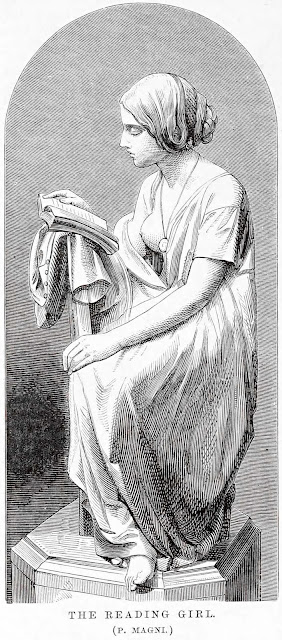This statue by Pietro Magni modeled in 1856 and carved in 1861 entitled The Reading Girl (La Leggitrice) stands in the National Gallery of Art, in Washington, DC.
The NGA gives this overview of the work:
Pietro Magni's marble statue The Reading Girl brought the Milanese sculptor international fame and recognition. It was exhibited numerous times at international exhibitions throughout Europe and America, each time to great public and critical acclaim. Stylistically it owes much to the artistic tradition of verismo or “realism” that characterized Italian art during the middle years of the nineteenth century, but it also recalls earlier aspects of Italian romanticism. In its seated pose and realistic carving of chair, clothing, and anatomy, The Reading Girl attests to many of the important verismo principles then being advocated by Italian sculptors, most notably by Magni's teacher at the Brera Academy in Milan, Vincenzo Vela (1820-1891). Magni's commitment to verismo ideas, however, achieves psychological complexity through a host of subtle details rich in their associative meanings.
The young girl sits in a common rush chair placed on a rough tile floor, which suggests her working-class origins. The back of the chair acts as a prop for both her book and the dress which drapes over the chair's back. Her seated position, turned sideways, creates a gentle shift in the axis of her body, reinforcing the feeling of absorption in her reading and discreetly calling attention to the fact that she wears only a nightgown, which has slipped from one shoulder to reveal her breast. A single tear streaks the young girl's left cheek near her eye. Suspended around her neck on a simple knotted cord is a portrait medallion of the Italian patriot Giuseppe Garibaldi.
The content of the book has obviously moved her. Its words (based on a text legible in the first exhibited version of the sculpture) are lines by the Italian poet and playwright Giovanni Battista Niccolini (1782-1861), whose writings celebrated themes of Lombard freedom and deliverance from Austrian oppression during the uprisings of 1848. This young reader responds, therefore, to sentiments that will soon find their fullest expression in the Italian Risorgimento. The Reading Girl may very well represent Italy itself, soon to come into maturity as a nation. In this regard, The Reading Girl fuses verismo concepts of truth to nature and close observation with emotional insight, all in service to a rising Italian patriotic sentiment.
Contemporary observers commented upon Magni's success in combining truth-of-the-moment realism with sincerity of expression. One English critic who viewed the work in the 1862 International Exhibition in London wrote:
Magni's "Reading Girl," truthful not only to the hem of a garment, to the turned leaf of the book, and the torn rushes from the bottom of cottage chair, but earnest as if the whole soul drank of the poetry and was filled, moves with a heartfelt pathos. (J. Beavington Atkinson)A year later, another writer remarked upon the sculpture's patriotic aspect:
Such ardent and patriotic thoughts, prophetic in their inspiration, stir the young Italian maiden's heart, and her earnest look of attention is wonderfully rendered by the artist. (J. B. Waring)Pietro Magni's The Reading Girl was a mid-century challenge, in marble, to the timeless quality and idealized content found in earlier neoclassical sculptures by Antonio Canova (1757-1822). In its livelier, more immediate, true-to-life aspects, it successfully appealed to a wide public and linked itself to the growing democratic vision of a united Italy. -- NGA
As Jones points out, there are many copies of this sculpture in many museums and collections around the world. The particular iteration of this sculpture found in the National Gallery in Washington is according to the NGA probably not the one exhibited in the International Exhibition in London in1862, but one purchased by the London Stereographic and Photographic Company in 1862.











No comments:
Post a Comment